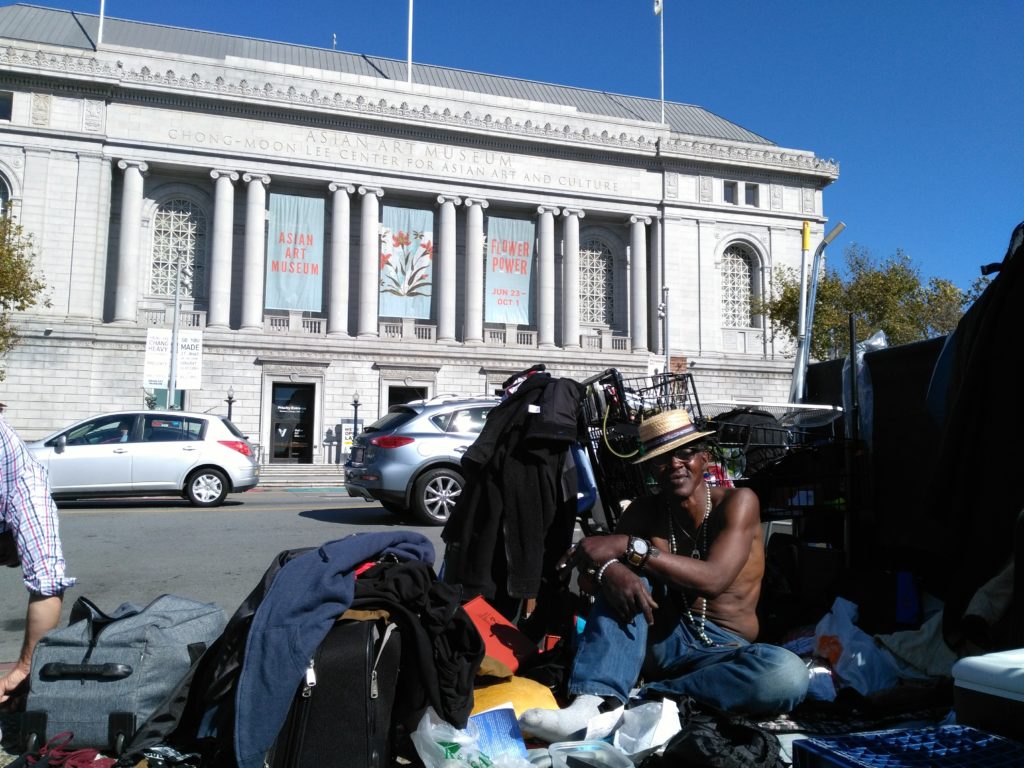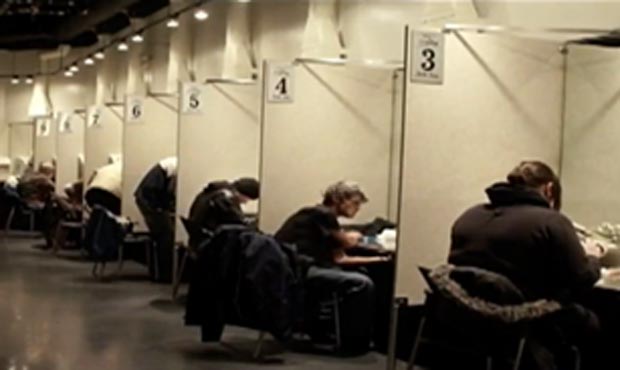
“I’ve … We’ve lost a lot a bunch of good people out here, and a lot has gotten way close to passing away,” says Terrence Dallas Stayton, after clearing his tears in his makeshift corner just a few yards from the main entrance to San Francisco City Hall. Dallas, as he prefers to be called, is well known to Glide’s harm reduction community outreach volunteers who gave him the usual: a bag full of clean syringes, cleaning pads, disposal boxes, and Narcan, which is used to treat overdoses. For many, the opioid crisis is as obvious as walking down the streets, but for him it is clear enough to make him cry as soon as he begins to share about the proposed safe consumption sites in San Francisco.
“Clean syringes! Condoms! Lube!” yells Jason, a member of Glide’s harm reduction staff, with a few SFPD officers keeping their eyes on the team. “They must have made a sweep, we should move further. People don’t like to be seen by the police taking them,” explains another member. The syringe exchange program was a new approach that first took place in San Francisco during the early ‘90s, running into opposition from the federal government. Only after the HIV epidemic had taken many lives, data showed that infected needles were a large part of it. What the outreach volunteers are doing is no reason for alarm by law enforcement or even the community, and the research is clear that these and other harm reduction services do more help to people with addiction and their communities.
Taeko Frost, western director of the Harm Reduction Coalition, describes harm reduction as the concept that a person has to be ready in order to stop using a substance, and that there’s a spectrum during recovery, with each person having individual requirements according to their own circumstances.
Frost has been advocating with many others for the opening of safe injection sites, and according to research done in other places that have them (mostly in Europe, though they also also located in Vancouver and a few other cities in Canada), it is clear that they do not increase crime nor do they increase drug use. Frost explains that the main opposition for these sites is not rooted in any reality.
“You are creating syringe shooting galleries” is the opinion of those who oppose the sites, but the argument is not based in any truth—and the data clearly shows that they are a path for recovery. She explains that the reason why the resources shouldn’t all be placed in drug rehabilitation centers is because not everyone is ready to go to them, and those who are put in them at the wrong time often overdose, and even die, after being “clean” out of those facilities.
Paula Lum is an expert advisor in the City’s new task force on safe injection sites, and there seems to be a unanimous agreement in city government for creating the legal structure that would allow these sites. She also explains that the designation of “clean” is part of the stigma.
Lum points out that she is only giving her opinion and not speaking as a representative of the task force, but she has been working with addiction, overdose, and intravenous drug-related diseases for more than 30 years at SF General Hospital and UCSF. She explains that the word “clean” implies that those who are using them are “dirty,” and the stigma of drugs is part of the reason why people use them.
“Even the American Medical Association agrees with the need of supervised injecting facilities,” she says. “Those in the medical community who oppose safe injection sites are usually convinced to support once they are exposed to the literature that shows it effectiveness.” She thinks that those who don’t advocate for them do so for usually personal reasons, since their own reputation might be at some kind of risk when the majority of the people don’t approve of them them.
However, she thinks it’s only ignorance and that people need to be educated about these issues, part of it because drug use carries such a big stigma that creates a cycle related to the shaming culture that “clean” or “dirty” creates. She thinks that they have to be well implemented, but that the community at large would benefit. People complain about dirty syringes and its impact on tourism, and when people lack empathy for individuals struggling with addiction, they usually see an easy solution in policing drug use.
Law enforcement, in fact, sweep out the streets for a night. That’s what Kyle Yergensen, a Tenderloin resident and concierge at the Hilton, noticed during the 2016 Super Bowl. The hotel itself does not have the problem of “people shooting drugs on the streets and dirty syringes” even if it is just a block away from Glide’s Harm Reduction headquarters. However, Yergensen found that during the Super Bowl, the sweeps made the people move to another street, and they are probably not going away unless solutions come from a deeper level.
“The opioids crisis is not epidemic, it is endemic” says Lum. The criminalization of drug use has not only led to a rise in the prison population, but has also failed to reduce its use or illegal trade. Just like with homelessness, it creates a self-perpetuating cycle, and both are often linked. Everyone who works in drug abuse and is familiar with the research done agrees that short-term solutions don’t work for reducing drug addiction, just as they don’t for homelessness.

“We should’ve had these places 10 years ago, the measure was considered 10 years ago but they had to wait until so many people died to act on it. Even London Breed changed her mind, and fucking Ed Lee is starting to talk about it in a positive way,” says Paul Harkin with a no-nonsense tone in his office at Glide. In 2007, the SF Department of Public Health held a symposium with community and health advocates that ended without conclusion. “If it were for me, I’d put it right here, even if they pass the law only at city level” he says “they are already doing it in our bathrooms, at least they could have some proper care,” but explains that law enforcement could seize the building because they don’t have the support of the state. In California, Assembly Bill 186 fell two votes short of passing and is waiting for next year to be reconsidered. However, San Francisco might consider going without the state approval, something that has been done with marijuana, same-sex marriage and syringe exchange. However, Harkin says that if the already existing places of harm reduction worked together to open safe-consumption sites, it wouldn’t have to wait another year. If that happens, many people will be saved, and the community at large would benefit.
Ending the stigma is a big part of their work, and thinking in it in an abstract way is different from viewing everyone as a human being. One of the outreach workers, John, began to volunteer with the program because from personal experience he knows about being rejected, labeled and dehumanized. “You see all types of people getting help from us” Harkin says. “One day a well-dressed lady in an expensive BMW asked us for supplies.” Moreover, his work is to treat everyone with dignity, a thing everyone in the outreach team does. “When you’re in a hard situation and feel that someone sees you as a human being, with compassion and respect, something changes,” he says.
Dallas, in front of the City Hall, says that the politics behind that stuff is keeping everyone back. His supplies, as for many others who asked them from the outreach team, are something he uses as part of the education he does with the issue. “Every week… they don’t listen to me, but at least 10 get OD. And sometimes we lose one.” He has seen heroin addiction since he was at least 10 years old, and has seen many changes done, but not enough. He agrees that safe injection sites would be a good idea, and his “adoptive son,” David, a young man who gives a small chuckle when being called that way, and retorts when Dallas says that he lost his sons by saying “and I lost my father” touching his heart with his fist twice, says that he should be a teacher. He thinks that if people had a place where they could be safe, with people who cared for them and treated them with respect, then they could “go watch a movie, watch TV and relax. Not do anything stupid after that.”
However, just like Harkin thinks that this is just a good start on how addiction should be handled, Lum says that there is no way to end the issue of substance abuse, and is going to be an ongoing battle, Dallas points his finger at a tall building behind the City Hall and says “if I had a billion dollars, I’d buy that building and put all the homeless folks in there.” And the research is solid on what he says. Sam Tsemberis published an American Journal of Public Health article in 2013, stating that people with mental disorders and substance abuse have a “97 percent housing retention rate and reduction of psychiatric symptoms at 12 months” and almost almost four times more adherence to drug treatment with methadone (51 percent compared to 13 percent) when the housing was combined with health care.
Anita Palepu, a professor at the University of British Columbia, reached a similar conclusion in another study of the Housing First initiative. The people living in homelessness in San Francisco are as diverse as the population who used to be housed, and some of them might turn to drugs out of desperation, being the younger people the most vulnerable, but secure housing has a bigger impact than any type of medical intervention for people without a place to stay safe. Supervised injection facilities are a first step and many homeless people would benefit from them, but the same compassion, or at least concern for anyone going through addiction should be something that the higher-ups in City Hall should also consider while doing housing policies.
There are no “clean” or “dirty” people, according to harm reduction advocates, and they deal with their own struggles and they can see that others have their own, but for people with addiction issues, even the only fact of being treated with respect, despite their circumstances, can be life-changing. ≠

